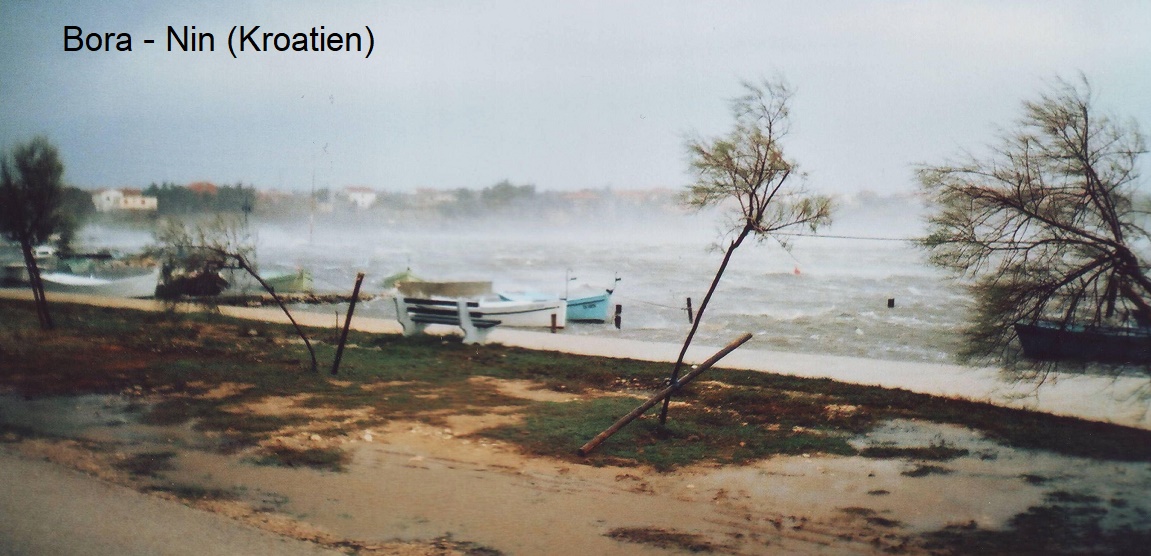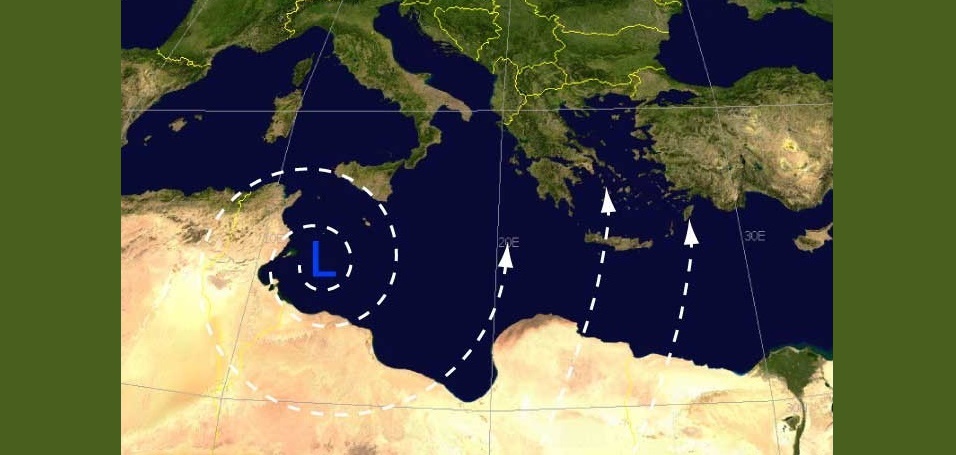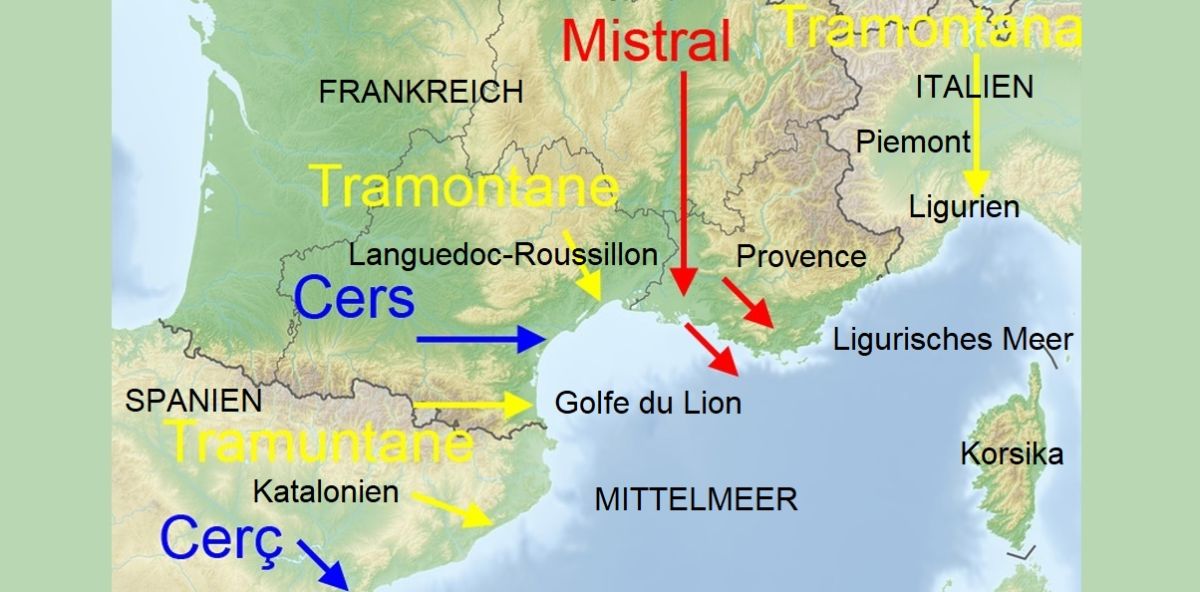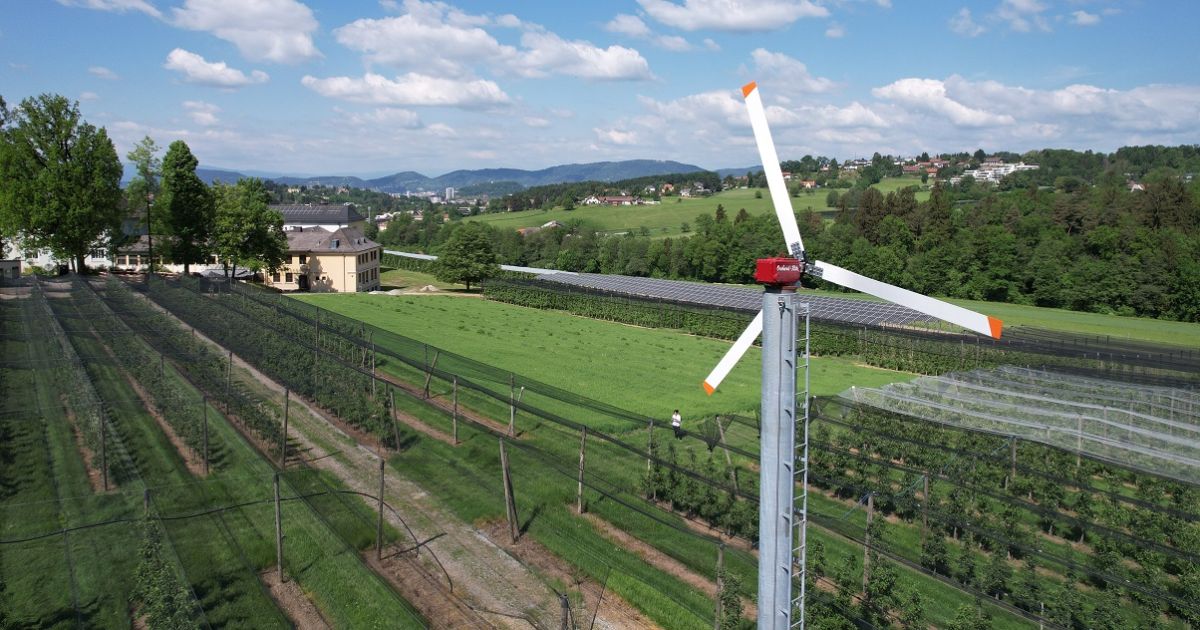In meteorology, wind (Latin ventus for blowing) is a directional, stronger movement of air in the earth's atmosphere as one of the many factors in the weather or in the long-term weather patterns of the climate. The main cause of wind is spatial differences in air pressure distribution. Air particles move from the area with the higher air pressure (the high pressure area) to the area with the lower air pressure (the low pressure area) until the air pressure is equalised. The greater the difference between the air pressure values, the more violently the air masses flow into the area with the lower air pressure and the stronger the wind resulting from the air movement. Wind speeds of 62 kilometres per hour or more are referred to as a storm (wind force 8) and wind speeds of 118 kilometres per hour or more are referred to as a hurricane (wind force 12 = maximum). The wind direction is usually given in the form of a compass direction from which the wind is coming.

The video clip (click to view) clearly illustrates the physical causes of wind.
Types of wind
There are different types of wind, including localised winds such as sea and land breezes, downslope winds, mountain and valley winds, as well as large-scale winds such as trade winds, polar and westerly winds. In addition, winds are categorised according to the height of the contraction into surface winds, high-altitude winds and tubular jet streams. Whirlwinds are winds that blow in vortices or rotate. Strong air movements can have both positive and negative effects in viticulture. Lower wind strength helps to maintain the important humidity in the rows of vines, which is particularly important in dry areas. Moist sea winds can have a positive moderating influence in dry or low-precipitation areas such as Portugal, California and South Australia.
Autan
The Autan (lat. Altanus = "the one blowing from the high sea") is a south-easterly wind in south-west France in the region around Toulouse and in the Tarn department (e.g. in the Gaillac and Pays d'Oc areas). It is a continuation of the Marin, which blows along the Mediterranean coast. Its gusts can reach over 100 kilometres per hour. It is divided into the "Autan blanc" (cold, dry, fair weather wind) and the "Autan noir" (warm, humid wind that can bring rain and thunderstorms).
Bise
Bise (from the Germanic Bĭsōn = to storm around) is a cold, dry wind. Cool air usually flows southwards from a strong area of high pressure in the north or north-east of Europe. The wind occurs in southern France (in the Rhône valley, for example, in the Côte Rôtie area), Switzerland and Italy. It is usually associated with clear weather. However, it can also bring overcast weather as "bise noire", possibly combined with clouds and rain.
Bora
The gusty downslope wind bora (derived from Boreas, the god of the north winds; Croatian Bura, Slovenian Burja, Italian Bora scura = cold gust of wind, cold downpour) is particularly dangerous and occurs on various coasts on the Adriatic, mainly in winter. It affects Italy (see Carso), Slovenia (see Primorska), Montenegro and Croatia. With wind speeds of up to 250 km/h, it is one of the strongest winds in the world. The picture shows a strong bora near the town of Nin in Croatia.

Cape Doctor
A cold, dry and gusty downslope wind in the Cape Town area in South Africa. The name is based on its purifying effect on the city air. However, it is feared by winegrowers because it can damage the vines.
Cers/Cerç
The Cers is a wind on the French Mediterranean coast in the Narbonne area between the Massif Central in the north and the Pyrenees in the south. It is similar to the Mistral because it also blows through a valley. It is a dry wind from the north-west to west, which is cold in winter and can become hot in summer. The Cers blows three out of four days throughout the year. It dispels the clouds and ensures fair weather. The "Circius" (vortex, whirlwind) was already mentioned under this name by Roman writers such as Seneca in the year 62 and by Pliny the Elder in the year 77.
Foehn
The foehn (Favonio or Tedesco in Italian, Fen in Slovenian, Jauk in Carinthian) is a warm, dry downslope wind that often occurs on the side facing away from the wind direction (leeward side) of larger mountains such as the Alps (Austria, Italy, Switzerland). In viticulture, it has a particularly positive effect in autumn after cold nights and ensures good grape ripening. It is said that a single foehn night increases the sugar content of the grapes by 1 Oechsle degree. In the Swiss canton of Graubünden, it is therefore also known as the "grape cooker", which is to be understood in a positive sense. Although a drying effect is undisputed due to the low relative humidity of the hairdryer (below 50%), there are doubts about the actual effectiveness and extent.
Marin
The Marin (French le marin = the sailor, sea) is a very humid onshore sea wind in the southern French coastal area. It blows from the south-east, usually strong and steady, sometimes fierce and occasionally gusty over land. It usually occurs in spring and autumn. Due to the high humidity, it brings heavy rainfall, especially on the south-eastern mountain slopes facing the sea on the Corbières, the Montagne Noire, the Cévennes and the first mountains of Provence. On the other side of the mountains, it is therefore dry, reinforced by a foehn effect. The extension of the Marin across the Aude valley and the Seuil de Naurouze to Toulouse is known as the Autan.
Meltemi
The name (Greek: Meltémi) is of Turkish origin and means "breeze, gentle wind". This wind prevails in the summer months in the eastern Aegean and blows as a dry north-westerly, northerly and north-easterly wind from the Greek mainland towards the islands of Crete, Santorini and Samos. It is pleasantly cool and always brings bright weather and good, clear visibility. However, it can also be feared due to fine grains of sand.
Mistral
The mistral (derived from "master"; also Mistrau, Magistral, Mestral, Maestrale) is a cold, dry and often strong downslope wind that is noticeable in the lower Rhône Valley in the areas of Châteauneuf-du-Pape, Gigondas and Rasteau, but also in the regions of Provence and Languedoc-Roussillon as well as in Corsica. It is caused by polar air flowing into the Mediterranean region. It can be desirable due to its cooling effect, but it can also be feared.

Scirocco
The scirocco (also sirocco, sirocco, scilocco) is a hot, dry desert wind, often laden with dust or sand, which blows from the Sahara towards the Mediterranean and reaches southern European wine-growing regions. Italy and Sicily (see Lison and Pantelleria) and Greece are particularly affected. It often occurs in spring, early summer and autumn. In extreme cases, it can reach the speed of a tropical cyclone.
Tramontane/Tramontana
The Tramontane (lat. trans montana = over the mountains) occurs on the French Mediterranean coast, in Languedoc from the mouth of the Rhône(Camargue) to the Pyrenees and in the neighbouring Spanish region of Catalonia to the south. It blows over the mountains of the Massif Central or the Pyrenees towards the sea. This distinguishes the Tramontane from the Mistral and Cers, which also blow from the land towards the sea, but through the Rhone Valley and from the Lauragais through the Aude Valley respectively. The two are therefore not downdraughts. The similar Tramontana isthe cold, often gusty wind blowing north/north-west in Italy(Liguria) and Croatia (Croatian Tramuntana).

Wind stress
If vines are exposed to high winds, they can also suffer from wind stress as a defence reaction. This manifests itself negatively in lower yields, impaired growth of shoots, foliage and grapes. As protection against the wind, the stomata in the leaves are closed by the vines, which results in reduced photosynthesis and therefore later grape ripening.
Protective devices against wind
Damaging effects caused by wind are prevented by plant covers (protective trousers) made of plastic or so-called windbreakers (barriers made of vegetation such as shrubs and trees or artificial installations).
Wind machines against frost
Artificially generated wind is used as a measure against the risk of frost (especially late frost in spring) in vineyards. In California (e.g. Napa Valley) and New Zealand, stationary or mobile wind machines (propellers with a diameter of up to 6 metres) are used to combat the dreaded radiation frost (frosty nights with no wind). This stirs up the cold ground air and mixes it with warmer layers above. Depending on the temperature difference between the air layers and their mixing, frost protection down to -1.5 °C to -2 °C can be achieved. Frost candles or heaters are also used.

Soil changes
Due to the constant influence of winds, there are aeolian changes in the soil structure, named after the Greek wind god Aeolus. Erosion is caused by strong winds. Fine material such as loess, silt (silt) or clay is released from the parent material such as loose rock and transported over long distances by the wind. The result is a gradual loss of fertile soil, which leads to damage to the ecosystem. See also under soil type and geology.
Fertilisation of the vine blossom
During the flowering period in the annual vegetation cycle of the vine, wind can also be involved in fertilisation, but it hardly plays a role due to the 99% self-fertilisation of the inflorescences.
Further information
See also other weather influences under irrigation, frost, drought, thunderstorms, hail, precipitation and weather, as well as general information on the subject under soil type, climate, meteorology and viticultural suitability.
Source: WIKIPEDIA Wind and wind systems
Video: ZDF/Pur+/Autorenkombinat/Tobias Schönke/Carina Schulz/Jochen Schmidt
Bora: by Andrej Šalov - Own work, Public domain, Link
Scirocco: Public domain, Link
Wind map: by Author Tschubby. Arrows, Own work, CC BY-SA 3.0, Link
(edited by Norbert F. J. Tischelmayer)
Wind machine: © Haidegg Research Station
Voices of our members

I have great respect for the scope and quality of the wein.plus encyclopaedia. It is a unique place to go for crisp, sound information on terms from the world of wine.
Dr. Edgar Müller
Dozent, Önologe und Weinbauberater, Bad Kreuznach